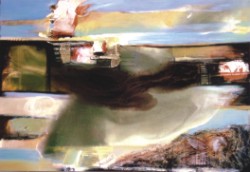|
Art
Poignant Images of '71
Fayza Haq
 |
Memory of bright & black ,71,mixed media on canvas |
Gulshan Hossain is better known exhibiting her work in foreign lands . The theme of her recent exhibition of paintings and prints in London was the Liberation War of Bangladesh. The series has been labelled "Memories of 1971". In one of her paintings amber lines stretch out like fans; they stand for dried blood. In the background are miniscule coloured buntings symbolizing victory. Humans are depicted as decimated and decomposed, the walls and windows of the neighbouring houses are reduced to rubble and bullet-ridden.
Another painting shows clothes and furniture of people who once lived a full life, but who had been removed by the cruel arm of genocide. With polythene and glue-- treated with heat and colour (acrylic and oil) -- the artist has created heaps that stand for the dead bodies. In one corner is a silk-screen work, which depicts the Pak army men taking away the people in boats, and killing off the boatmen to remove any witnesses of the mindless, brutal killing.
Another painting once again deals with decomposed bodies of people killed in the ruthless raid. Gulshan , who had members of her family brutally shot in 1971, feels deeply about the issue. With silk-screen and cardboard collage, the artist has once again brought in realistic delineation of death and disaster through human hands.
Apart from these are photo-etching and calligraphy. With the help of zinc plates, the artist had depicted scenes where one sees a dirty, dark, waterhole full of broken bricks. This contains the tortured bodies of students and intellectuals. The scenes are developed from actual tiny, newspaper photographs, which Gulshan enlarged and printed, before adapting them to her own prints.
Gulshan Hossain has completed her masters from UK and has presented three exhibitions in the UK -- which are indeed an achievement for any Bangladeshi artist. She speaks about her experiences, sitting in her studio at Dhanmandi ."I had applied to UCL, St. Martin, Chelsea School of Art, and University of Southampton. I was accepted at all four places. From Southampton I was offered a small scholarship as well, and so I decided to go there," says Gulshan.
 |
Memories of dried blood 1971,mixed media on canvas |
She was impresssed by the system of teaching at Southampton. There was constant guidance and exchange of ideas. "When we first joined, we had to give a research proposal of the work we intended to do. We also had individual tutorials every week. I worked under Prof. Beth Harland. “I used to join work at 9 in the morning, and returned at 11 pm. Till seven in the evening I worked on my painting, after which I went to learn print making, for which I didn't have to pay. In between work, we got together and had breaks of coffee on a large, inviting table."
Summing up her work, Gulshan says, "I've always explored the varied facets of nature and history through my semi-abstract compositions. In depicting the Liberation War of Bangladesh, I've taken elements from my life, thoughts, memories and feelings. I've explored my style of abstraction through different materials and techniques. In my work colour is used to present form, content, image and feeling. I've tried to portray my images with fast moving fluidity of drawing and painting using a water medium. Printmaking also allows me to experiment with different materials. I've used photographs throughout as the main tool for my recording code."
Gulshan has exhibited her work in Canada, USA, Europe, Middle East and Tokyo.
Copyright
(R) thedailystar.net 2009
|
